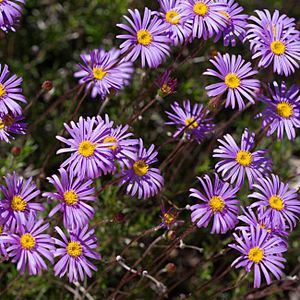Fringed daisy bush facts for kids
Quick facts for kids Fringed daisy bush |
|
|---|---|
 |
|
| Olearia ciliata near Murray Bridge | |
| Scientific classification | |
| Kingdom: | |
| (unranked): | |
| (unranked): | |
| (unranked): | |
| Order: | |
| Family: | |
| Tribe: | |
| Genus: |
Olearia
|
| Species: |
O. ciliata
|
| Binomial name | |
| Olearia ciliata |
|
The fringed daisy bush (also known as Olearia ciliata) is a pretty, small shrub. It has bright purple-blue flowers that grow in big bunches on a single stem. You can find this plant in many parts of southern Australia.
What Does It Look Like?
The fringed daisy bush is a small shrub that grows upright and spreads out. It usually reaches about 15–30 cm (5.9–11.8 in) tall. Its stems are a bit woody and wiry, often reddish, and can be 2–15 cm (0.79–5.91 in) long. These stems feel rough because they have short hairs and fine ridges. They usually branch out from the bottom of the plant.
The leaves of the fringed daisy bush are bright green on top. They can be rough or slightly smooth. The underside of the leaf is paler and hairy. Each leaf is about 150 mm (5.9 in) long and attaches directly to the stem without a stalk. The leaves are long and narrow, tapering to a fine point. Sometimes, they might have small lobes at the tip. They are usually 0.5–2 cm (0.20–0.79 in) long and 1–2 mm (0.039–0.079 in) wide. The edges of the leaves are rough with short white hairs, rolled under, and look like they have a fringe.
The flowers grow one by one at the end of a stem called a peduncle, which can be 2–25 cm (0.79–9.84 in) long. There are three green, overlapping leaf-like parts called bracts around the flower. These bracts are woolly, narrow, and also fringed. The flowers themselves are 2–3 cm (0.79–1.18 in) wide. They have beautiful mauve to purple "petals," which are actually special parts called ligules. These ligules are 12–15 mm (0.47–0.59 in) long. The center of the flower is yellow and made up of 40 to 75 tiny disk florets.
After the flower blooms, it produces a dry, one-seeded fruit. This fruit is a small capsule, about 2 mm (0.079 in) long. It can be smooth or have fine, soft hairs and faint lines along its sides. The fringed daisy bush usually flowers from late winter to spring, but sometimes you might see it bloom in autumn too.
Its Name and Family Tree
The fringed daisy bush was first officially described in 1837 by a scientist named George Bentham. He called it Eurybia ciliata at that time. His description was published in a book called Enumeratio plantarum .... collegit Carolus liber baro de Hügel.
Later, in 1867, another scientist named Ferdinand von Mueller moved the plant into the group (or genus) we know today as Olearia. The second part of its scientific name, ciliata, comes from the Latin word cilium. This word means "eyelash" or "eyelid," which probably refers to the fringed edges of its leaves or bracts.
Where Does It Grow?
The fringed daisy bush is a common plant found in many parts of southern Australia. It prefers to grow in sandy soils that drain water well.
In the state of Victoria, you can find it in sandy and mallee heath areas in the north-west. It also grows in scattered places in the woodlands of the Grampians, Brisbane Ranges, and Wilsons Promontory.
In Western Australia, this plant grows on rocky or sandy soils. It can be found on coastal dunes and sand plains, mostly near the towns of Esperance and Albany.
In South Australia, it mostly grows along the coast. In Tasmania, you can find it along the east and south-east coasts.

